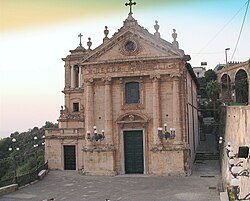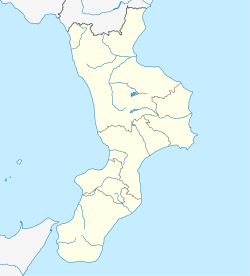This article needs additional citations for verification. (March 2019) |
Bagnara Calabra (or simply Bagnara) is a comune (municipality) in the Province of Reggio Calabria in Calabria, southern Italy. It is located in the hills facing the Tyrrhenian Sea on the southern tip of the region, about 100 kilometres (62 mi) southwest of Catanzaro and about 25 kilometres (16 mi) northeast of Reggio Calabria.
Bagnara Calabra | |
|---|---|
| Comune di Bagnara Calabra | |
 Carmine's Church | |
| Coordinates: 38°17′N 15°49′E / 38.283°N 15.817°E | |
| Country | Italy |
| Region | Calabria |
| Metropolitan city | Reggio Calabria (RC) |
| Frazioni | Ceramida (Calabrian Greek: Keramida), Solano, Pellegrina |
| Government | |
| • Mayor | Francesco Albanese Agostino |
| Area | |
• Total | 24 km2 (9 sq mi) |
| Elevation | 50 m (160 ft) |
| Population (31 December 2012)[2] | |
• Total | 10,469 |
| • Density | 440/km2 (1,100/sq mi) |
| Demonym | Bagnaroti |
| Time zone | UTC+1 (CET) |
| • Summer (DST) | UTC+2 (CEST) |
| Postal code | 89011 |
| Dialing code | 0966 |
| Patron saint | St. Nicholas of Bari |
| Saint day | 6 December |
| Website | Official website |
History
editThe first organized village for which we have historical proof was around 1085 AD, with edification of "S. Mary's V.G. and XII Apostles Abbey Nullius" ordered by Roger I of Sicily.
Other historical assumptions supported by indirect proofs allow dating much further back, to being directly connected with Mamertini (sons of war-god Mars), following the First Punic War. Supporting this theory, ancient coins with the likeness of Mars were discovered and documented in this area around 1800.[3]
Roman presence is historically proven by the ancient "Via Capua-Regium", also known as Via Popilia, built in 132 BC, through Bagnara's territory.
During the Roman era, the village was known as "Balnearum", at that time a thermal spring used by Romans.[4]
Others claim that Bagnara was founded by Phoenicia around the 8th century BC, but there's no archaeological proof supporting this theory.
Since 1130 AD, Bagnara was part of the Kingdom of Sicily established by Roger II.
The village was almost completely destroyed by the 1783 Calabrian earthquakes and tsunami. It is recorded as the most powerful in the area, killing 59% of the population and collapsing the Abbey Nullius. The only evidence left of a late-eighteenth century building is Carmine's Church, which was rebuilt after the earthquakes.
On 24 August 1860 followed by ten official Giuseppe Garibaldi fighting for Italian unification reached Bagnara where they were host by a member of the National Guard.
In the past the name was just Bagnara, but after the 1861 and unification of Italy, it became Bagnara Calabra to distinguish it from Bagnara di Romagna.
Bagnara was also heavily hit by the 1908 Messina earthquake.
During World War II Bagnara Calabra was involved in operations in southern Italy, which began the Allied invasion of Italy. Starting 21 July 1943, some parts of the village were lightly bombed by the Allies, in order to attack Wehrmacht forces that were preparing to retreat.[5] Albert Kesselring and his staff strategically chose not to defend Calabria, leaving only the 29th Panzergrenadier Division's 15th Panzergrenadier Regiment, and began the German retreat. On 3 September, most of this unit was in prepared positions at Bagnara, some 40 km (25 mi) from the landings which it had orders to hold until 6 September.
On 3 September 1943 the British Eighth Army's XIII Corps, composed of the 1st Canadian and British 5th Infantry Divisions and commanded by Lieutenant-General Miles Dempsey, launched Operation Baytown under General Bernard Montgomery's direction. At 4:30 AM on 4 September 1943 the retreating Germans blew up the Caravilla Bridge.[6] On 4 September, the British 5th Infantry Division reached Bagnara Calabra.[7]
Bagnara preserves evidence of this British presence since the rail station area of the village is commonly known as Rione Inglese (English Quarter).
Historical monument
- The Aragonese Tower or Capo Rocchi Tower, locally known as Roger's Tower, was built in the 15th and 16th centuries.
It is located in the historic fishermen district known as Marinella. In ancient times the Tower was known as the "32nd Tower of the Calabria Ulterior". It was built as a part of a military system of several watchtowers to guard against the incursions of Saracens along the Tyrrhenian coast.
- Bridge of Caravilla -built on 1825- is a monumental stone bridge, which is notably passing thrice.
This Bridge is famous for a distinctive trait. It is probably the only one in Italy (perhaps on the World), since the same road cross the same bridge (passing down to two arches and turning up the bridge) three times. It is a part of Strada statale 18 Tirrena Inferiore. After being blown up by German mines on 4 September 1943, the bridge was rebuilt in 1943 by the Allies with the cooperation of the women of Bagnara Calabra.
- Fonte Garibaldi
A popular legend relate that Garibaldi stopped twice to drink water on the same fountain. A Palladian style fountain was edificated on 1866 in order to remember Garibaldi in Bagnara.
- Audere Semper
In the central square of the village is located a marble monument to remember Vincenzo Fondacaro. It is a marmoreal representation of the legendary "Leone di Caprera",a small 9 meter boat which on 1880-1881 Fondacaro and his crew recorded a brave endeavour crossing the Atlantic Ocean.
Geography
editBagnara Calabra borders the Tyrrhenian Sea on the west. It is located by a bay, embraced by overhanging hills which extend to the cliffs down to the sea, within a Calabrian coastal area known as the "Violet Coast".
Bagnara looks out on north-east Sicily, across the Strait of Messina. The Aeolian Islands can be seen to the west across the Tyrrhenian Sea.
The municipality of Bagnara Calabra contains territorial subdivisions, mainly boroughs and hamlets called "frazioni", such as Ceramida, Solano, and Pellegrina.
Bagnara Calabra borders the following municipalities: Melicuccà, Sant'Eufemia d'Aspromonte, Scilla, and Seminara.
Economy
editBagnara is known in Calabria and Italy as the maincenter of production of a renowned torrone which it has awarded with the quality brand of "I.G.P.". But overall the village is known for the ancient and rare way of fishing for swordfish, with an ancient boat known as felucca or passerella, where the fisherman hunts the Cavalier (as the swordfish is called by the oldest fishermen) with a harpoon. Between 1950 and 1970 the boats were modified with engines, but previously - for thousands of years - the ancient fishermen used sails. Before 1950 this kind of swordfish fishing boat was made by hand, with boats racing to chase swordfish.
Bagnara has traditionally been a fishing and agriculture center, with several terraces converted to vineyards for the cultivation of wine grapes. It was a highly esteemed area of Zibibbo vineyards. This farming has been lost because of emigration.
It is also a tourist center in the summer, and recently even in other seasons Bagnara has become an appreciated location for passionate flying paragliders who are attracted by an amazing landscape.
Transport
edit- Railway station -
- Highway -
People
edit- Vincenzo Fondacaro (Bagnara 3 March 1844 – Atlantic Ocean October 1893), sailor, navy captain, officer of Merchant Royal
- Mia Martini (1947–1995), singer and songwriter
- Loredana Bertè (born 1950), singer and songwriter
- Benito Carbone (born 1971), football player
References
edit- ^ "Superficie di Comuni Province e Regioni italiane al 9 ottobre 2011". Italian National Institute of Statistics. Retrieved 16 March 2019.
- ^ All demographics and other statistics from the Italian statistical institute (Istat)
- ^ Fiumano, G (1883–1884). Monografia Storica di Bagnara Calabra ( ... -1085 ? ).
- ^ Appiano, Storia Romana. De bellis civilibus - IV.
- ^ Spinoso, Vincenzo. Diario 14 July 1943 - 27 October 1944. Archivio Storico Fotografico Bagnarese.
- ^ Spinoso, Vincenzo. Diario 14 July 1943 - 27 October 1944. Archivio Storico Fotografico Bagnarese.
- ^ Molony, C J C (2004). The Mediterranean and Middle East Volume V : The Campaign in Sicily and the Campaign in Italy 3rd March 1943 to 31st March. p. 241.
External links
edit- Official website Archived 1 September 2006 at the Wayback Machine


